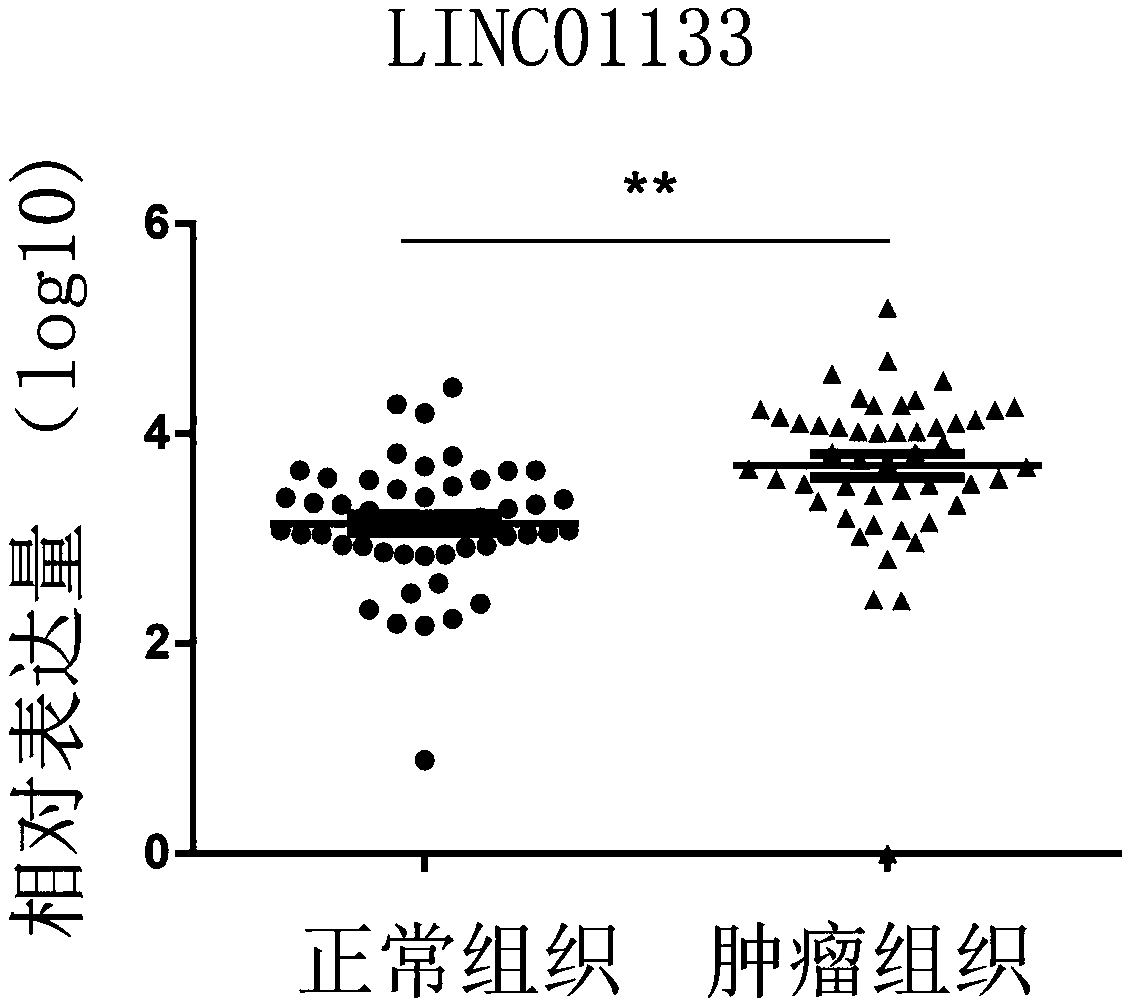Pancreatic duct adenocarcinoma marker and application thereof
A pancreatic ductal adenocarcinoma and biomarker technology, applied in the field of tumor diagnosis and molecular targeted therapy, can solve the problems of only 15%, less than 20% survival rate, easy recurrence and metastasis, etc.
- Summary
- Abstract
- Description
- Claims
- Application Information
AI Technical Summary
Problems solved by technology
Method used
Image
Examples
Embodiment 1
[0018] Example 1: The relationship between the LINC01133 gene and pancreatic ductal adenocarcinoma was mined through the database, and the difference in the expression level of the LINC01133 gene in pancreatic ductal adenocarcinoma patient specimens was compared between cancer and paracancerous.
[0019] The Cancer Genome Atlas (TCGA) database contains multiple levels of data information for various tumor types, including: miRNA, mRNA, protein profile, mutation profile, clinical diagnosis information, etc. These data provide a rich resource for tumor data analysis. Therefore, we first analyzed the correlation between LINC01133 gene and cancer with the help of TCGA database (https: / / tcga-data.nci.nih.gov / tcga / ).
[0020] (1) Three sets of gene chip data (GSE15471, GSE16515, GSE32676) mined in the GEO database (https: / / www.ncbi.nlm.nih.gov / gds / ) were selected for analysis. Among them, the gene LINC01133 was differentially expressed in the cancer and adjacent tumors in the three...
Embodiment 2
[0023] Example 2: Combined with the clinical samples of 134 patients with pancreatic ductal adenocarcinoma in the First Affiliated Hospital of Sun Yat-sen University, RT-PCR was performed to detect the expression of LINC01133 gene and different samples of pancreatic ductal adenocarcinoma patients.
[0024] The detection process is as follows:
[0025] 1. Extract total RNA from pancreatic ductal adenocarcinoma tumors and matched normal tissues,
[0026] (1) About 20mg of fresh or frozen tissue at -80°C, add 1ml Trizol and grind on ice. You can cut the tissue with scissors first. To prevent overflow, generally add 400ul Trizol first, grind it fully, and then make up to 1ml. Place at room temperature for 5-10min.
[0027] (2) Add chloroform according to the volume ratio of Trizol and chloroform at a ratio of 5:1, vortex for 30 s, place at room temperature for 5 min, and centrifuge at 12000 g for 15 min at 4°C.
[0028] (3) Aspirate about 400ul of the supernatant layer, try to b...
Embodiment 3
[0059] Example 3: Detection of the influence of LINC01133 on cell growth in pancreatic ductal adenocarcinoma cells SW1990 and BXPC3.
[0060] First, the LINC01133 gene was knocked down in SW1990 and BXPC3 cells using siRNA gene editing technology. Control cells and LINC01133 knockdown cells were cultured in DMEM / F12 complete medium (DMEM+10% fetal bovine serum+100-U / ml penicillin / streptomycin) at 37°C in a 5% CO2 incubator. After the cells grow on the wall, take the cells in the logarithmic growth phase, extract the total RNA, and test the knockdown efficiency of the LINC0133 gene. The results are shown in Figure 4
[0061] Then, cells were trypsinized and counted at 2x10 per well 3 Cells were seeded in a 96-well plate and cultured in a 37°C incubator. At 12h, 24h, 36h, and 48h of cell culture, the cells were digested with trypsin and counted. It can be seen from the results that the growth rate of SW1990 and BXPC3 cells was significantly reduced after knocking out LINC01...
PUM
 Login to View More
Login to View More Abstract
Description
Claims
Application Information
 Login to View More
Login to View More - R&D Engineer
- R&D Manager
- IP Professional
- Industry Leading Data Capabilities
- Powerful AI technology
- Patent DNA Extraction
Browse by: Latest US Patents, China's latest patents, Technical Efficacy Thesaurus, Application Domain, Technology Topic, Popular Technical Reports.
© 2024 PatSnap. All rights reserved.Legal|Privacy policy|Modern Slavery Act Transparency Statement|Sitemap|About US| Contact US: help@patsnap.com










